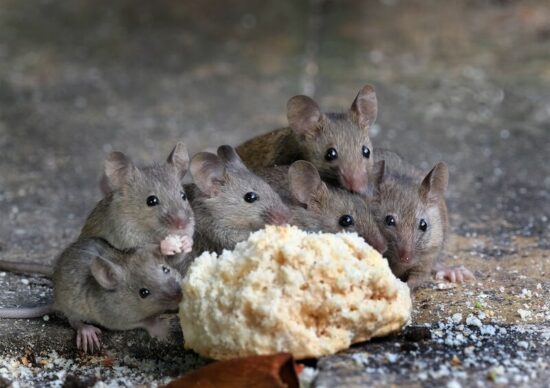As common as mice are, many people don’t know much about their social behavior and how they choose to live with others. They see a mouse or two in their home and don’t know if that means there are more hiding or not!
This guide covers if mice travel in packs or live alone, so you can understand what these critters are up to in your home.
Table of Contents
Mouse Social Behavior
Mice might seem like nothing more than pest creatures, but they have surprisingly sophisticated social skills. These animals can develop strong bonds with others. The rodents can play with companions, cuddle with others for warmth, and more.
Those dreaded high-pitched squeaks you hear? They’re how mice communicate with one another. They can also use their sense of smell and physical interaction.
What’s interesting about mice is how they form social structures. Groups often have a social hierarchy, and their individual statuses depend on factors like age, sex, etc. The pecking order is observable in established mice communities, and scientists believe it’s a way to curb aggressive behavior and maintain the tight-knit bond of a community.
Do Mice Travel In Packs?
We know that mice are social, but do they travel in packs or live alone?
Many people assume that mice are solitary creatures. We have movies and cartoons to thank for that. But in reality, these animals are more likely to live and scavenge with others.
As we said earlier, they’re capable of forming tight bonds. Not only that, but they have a social totem pole that dictates responsibilities and overall social status! It’s fascinating to observe, but it’s awful if you’re dealing with a mouse infestation.
You may see a mouse living alone every once in a while. Mice can venture to areas near the nest on their own. But they rarely travel from one place to another without at least one other mouse as a backup.
These creatures prefer to travel in pairs or groups. There’s strength in numbers, and traveling as a pack offers more protection.
Mice also move as a unit to migrate the colony. It’s rare to find a mouse nest with only a single rodent. They create a large nest, and every mouse works to support it (more on that in a bit).
When the group has to move to a new location, they travel as one for safety. If you ever stumble upon a single mouse that seems to be living alone near a nest, there’s a good chance that the others actually scurried to safety.
These animals are notoriously skittish, preferring to stay in the shadows and out of the light. So when you turn on the lights, they quickly find a hiding spot. Unfortunately, some aren’t so lucky and get separated from the group.
Do Mice Live In Groups?
As you probably gathered already, mice do not live solitary lives. They can occasionally venture into the unknowns on their own, but they usually require the support of others to survive. For this reason, mice live in pretty large groups.
If you find a nesting area, there won’t be many small clusters in one concentrated area. Instead, it’ll be one massive nest full of mice!
Mice prefer to live in dark, secluded areas of the home. They choose a quiet spot that doesn’t have too much human traffic. That’s why you often see nests in basements, attics, and other rarely used areas of the home.
You might spot them venturing into holes in the wall, too. These pests love to get into those tight spots to set up shop as a group and drive you crazy!
How mice end up finding their new living spaces can vary. Sometimes, a pair will go off to scout for fresh arrangements. Once they find something, they establish a trail that the entire group of mice can follow when ready to migrate.
Moving nests is often necessary if a new disturbance arises. Whether you or another pest, the nest tries to migrate to safer areas.
Once they establish a nest, the entire group works together. The animals collect nesting materials and set up a comfortable nest for sleeping, eating, and breeding.
How Many Mice Typically Live Together?
So, how many mice will typically be found in the same pack?
There’s no concrete number, and the number of mice in a group depends on how they’ve set up their living situation. These animals are social and rely on one another to get by. But they aren’t forced into living with the nest!
Here’s the thing about mice: They reproduce very quickly. A healthy adult female will have litters of six to eight mice about ten times a year. That’s a lot of young mice that can live their entire lives under your roof!
If you don’t address infestations quickly, they can get out of hand faster than you realize. But does that mean that you’ll see a group of hundreds?
Probably not.
The average group or pack of mice usually has somewhere between 12 and 24 rodents. That’s still a lot, but it’s not as big as it could be.
After giving birth, females will raise their young. During those first few weeks of life, the babies rely on their mothers for everything. From food to safety, the mother takes care of it all.
But mice grow up pretty fast. After about 21 days, they’re old enough to stop relying on their mothers and venture out into the unknown. Many will leave the nest (either alone, in pairs, or in a pack).
A few might stay behind, but most will look for other mice to reproduce and create a new family. What does that mean for you?
Mice could make their way outside the home to build a new nest and reproduce. But they can also stick around, resulting in multiple mice colonies in your home!
When Are They Alone?
Mice prefer to be in a pack with others. There’s safety in numbers, and the social bond they create is critical to their survival. A mouse going out into the unknown alone would be like if you ventured into dangerous unexplored lands on your own with zero support.
It’s not wise or safe.
That said, it can happen. Mice will occasionally travel alone in search of food. It’s a rarity, but you might witness it yourself.
Usually, this only occurs when a mouse feels safe in its surroundings. Maybe the colony has lived in the same uninterrupted area for a long time, and the mouse knows how to get around. When these rodents search for food, they don’t venture too far.
They tend to be no more than 30 feet away from the nest. That’s a reasonable distance because most mice can make it back to safety should anything come up.
Again, mice usually like to scavenge in pairs or small groups. But the occasional solo trip will happen.
You also might encounter a mouse on its own if it gets separated from the group. This happens when a lone mouse is incapable of hurrying to safety with the rest of the group at the first sign of trouble.
Will One Group Of Mice Attract More?
A single group of mice could attract others in the area. Now that you understand how mice reproduce and often leave the nest upon maturity, it’s not hard to see how you can have multiple nests in the same home.
So how does the attraction occur?
Mice give off pheromones when they travel. A pack of 12 to 24 mice migrating to another nesting location leaves behind a pheromone trail that others can’t ignore.
The pheromones are how mice communicate. These animals are territorial, so communication isn’t always great.
It’s not uncommon for the attraction to result in aggression. Sometimes, small groups will merge into one, so it’s not a behavior you want to ignore. Just because you eliminate one group of mice doesn’t mean that others aren’t around or that future clusters won’t take advantage of that old nesting spot!
Conclusion
Now that you know all the situations where mice travel in packs or venture out on their own, you can use this information to help assess your current situation. Just because you see a mouse by itself, it doesn’t mean you don’t have a more extensive infestation!
As always, be thorough when examining your own home. You never know what little critters have set up shop!


